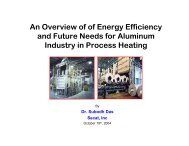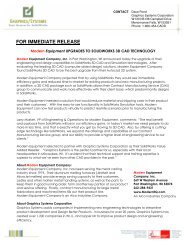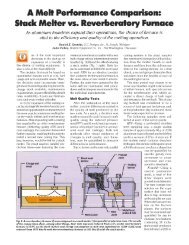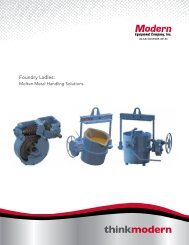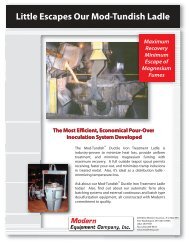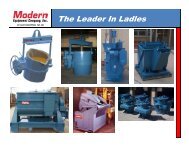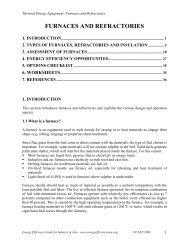ITP Metal Casting: Advanced Melting Technologies: Energy Saving ...
ITP Metal Casting: Advanced Melting Technologies: Energy Saving ...
ITP Metal Casting: Advanced Melting Technologies: Energy Saving ...
Create successful ePaper yourself
Turn your PDF publications into a flip-book with our unique Google optimized e-Paper software.
3.3 <strong>Melting</strong> Process Emissions<br />
Emissions formed as a result of the melting process are a concern in improving melting<br />
technology. Emissions are primarily generated from two sources during the melting process:<br />
• Emissions related to energy supply<br />
• Emissions related to preparing, refining and treating<br />
<strong>Energy</strong> supply emissions are the result of combustion either at the melting facility or at the plant<br />
generating the electric power used in melting. Preparing, refining and metal treating also result in<br />
emissions that are related to the raw materials brought into the process.<br />
Sixty percent of the metal casting industry’s energy requirements is supplied by natural gas and<br />
27% from electricity. The remainder includes other fuel sources such as coke and breeze. 11<br />
Natural gas is the cleanest burning of all the fossil fuels. Composed primarily of methane, the<br />
main products of the combustion of natural gas are carbon dioxide (CO2) and water vapor.<br />
Emissions of nitrogen oxides (NOx), sulfur dioxide (SO2) and particles from natural gas<br />
combustion are one to three orders of magnitude lower than that for coal and fuel oil, as shown<br />
in Exhibit 7.<br />
Emissions<br />
(pounds per billion Btu of energy input)<br />
Natural Gas Oil Coal<br />
Carbon Dioxide 117,000 164,000 208,000<br />
Carbon Monoxide 40 33 208<br />
Nitrogen Oxides 92 448 457<br />
Sulfur Dioxide 1 1,122 2,591<br />
Particulates 7 94 2,744<br />
Mercury 0 0.007 0.016<br />
Source: EIA - Natural Gas Issues and Trends 1998<br />
Exhibit 7: Fossil fuel emission levels<br />
<strong>Melting</strong> systems that use electricity do not produce onsite emissions related to the actual heating<br />
of materials. However, significant offsite emissions are produced in the generation and<br />
transmission of electricity. These offsite emissions are directly related to the fuels used to<br />
produce electricity. The major fuels for electric power generation are coal, producing about 51%<br />
of the electricity in the United States; nuclear, producing 20%; and natural gas, producing 6%.<br />
The low efficiency of electricity generation and transmission is also an important factor to<br />
consider in energy and emission analyses. It requires about 10,600 Btu of fuel to produce 1 kWh<br />
(3,412 Btu) of electricity. When coke is used as a fuel and a carbon source in melting furnaces<br />
(e.g., for iron and steel melting), emissions consist mainly of CO2 and CO from incomplete<br />
combustion and to a lesser extent, NOx and SOx.<br />
Emissions related to preparing, refining, and treating are generated in varying amounts<br />
depending on the degree of processing that must be accomplished. These emissions result from<br />
the dirt, moisture, and metallic impurities in the metal charge; erosion and corrosion products<br />
from the metal’s contact with the refractory; and the addition of alloying elements and treatment<br />
chemicals used for removal of impurities and dissolved gases.<br />
8



